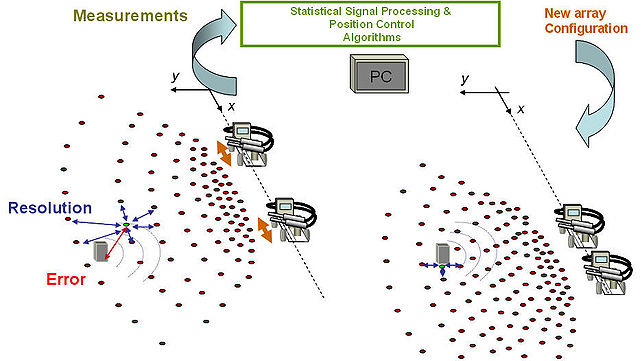Convergence & Divergence
<sidebar>Robotic Sensing: Adaptive Robotic Control for Improved Acoustic Source Localization in 2D Nav</sidebar>
Overview
The distance between the pairs of microphones, also controls the spatial distribution of the web of possible points of localization. Increasing this distance spreads out the points of possible estimation so that the system has a larger range of localization. It increases the resolution in the periphery of the system's field of view, which results in more accurate localization of sound sources farther away, in both the 'x' and 'y' directions in the diagram below.
Conversely, bringing the pairs closer together has the effect of narrowing the system's field of view, decreasing its ability to locate distant sources, but increasing its resolution for points near the middle of the field of view and close to the microphones in the 'y' direction.
Both shifting and shortening of the distance between the robots are shown in the two figures below. The red dots shown represent possible points of localization of the system for the particular physical parameters and sampling frequency. The one green dot shown in each figure represents the point at which the system estimated the sound source. In the left figure the system is shown before robot movement has taken place. The arrows drawn here around the green dot convey the distance from this green dot to the possible points of localization that are the direct neighbors of this green dot. These distances represent the local resolution around the source.
The right figure represents the system after robot movement has taken place. The arrows from the green dot to its neighboring dots show much shorter distances here. This conveys that the system has an improved resolution around the sound source. Accuracy of the resulting estimation would therefore be better.
Illustration
- This diagram shows the Mode 1 in Divergence mode.
- The lighter colored components indicate the previous positions of the robots.
- Pale arrows indicate a movement from the previous position.
- Labels with an ( ‘ ) in them indicate the newest values of the labeled variables.
- The robots were moved further apart by increasing the magnitude of the U vector without changing the location of P or the direction of the U vector, Theta. Alpha and Beta were also adjusted to point the robots at the sound source for higher resolution.

